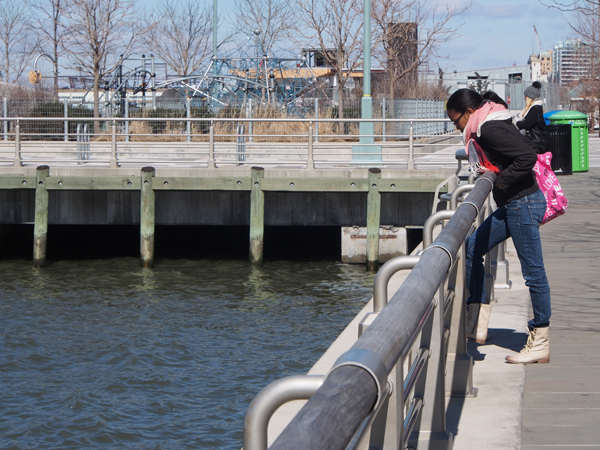
Tribeca section of the Hudson River Park.
PRO & CON
PRO: By H. Claude Shostal | As a residential property owner within the boundaries of the proposed Hudson River Park Neighborhood Improvement District, I fully support the formation of the H.R.P. NID.
Hudson River Park and the other waterfront parks that have been developed over the past few years have brought us back to our harbor roots, improved our quality of life and vastly upgraded nearby neighborhoods and their property values.
I have had the good fortune to be involved in many of these efforts. Beginning as the general manager of the State Park Commission for New York City, I helped start the planning and construction of Riverbank State Park, and opened Roberto Clemente State Park in the Bronx, the first state park in New York City. In that role and then working for the City, we helped to bring the South Street Seaport into being. Then, as president of the Regional Plan Association, I served on the board of Riverside South with the creation of that waterfront park space as out highest priority.
At R.P.A., we also led the efforts to create Governors Island as a great public open space and helped in the advocacy for Brooklyn Bridge Park and the evolution of the conservancy on whose board I still serve. I also served on the steering committee with Al Butzel that spearheaded the creation of the Hudson River Park Trust.
The lessons from this experience are clear. First, the value of these parks to neighbors, users and the city as a whole is immense. Second, since the new state park investments of the early 1970s, all of the new waterfront parks came into being only as the result of a new model of public/private partnership. In this model, state and city government has come up with all or most of the capital funding and private revenue streams account for most or all of the operating funds. They would not have happened if government had been locked to bear the ongoing maintenance costs.
Third, waterfront parks are uniquely costly to maintain. The upkeep of bulkheads and piers built out into the water combined with exposure to waterfront weather, which is growing ever more severe, require ongoing costly capital maintenance to keep these investments from crumbling in their difficult environments.
Finally, looking to government to be responsible for this capital maintenance sentences these great new parks to a life of deterioration and decay.
The budget shortfalls facing Hudson River Park have been well documented and are alarming. Filling the gaps will require a variety of new revenue sources and probably state legislation to permit some of them. The proposed Neighborhood Improvement District takes a proven tool that has served many commercial and residential areas extremely well and adopts it imaginatively to the needs of Hudson River Park. It is a tool that other parks would be wise to investigate.
The Hudson River Park NID proposal has been diligently researched and exhaustively vetted. It is reasonable, it is prudent and it is necessary.
Government has done its part. It is now time for us — local residents and businesses — to do our part and support the creation of the Hudson River Park NID.
H. Claude Shostal is a residential property owner within the boundaries of the proposed Hudson River Park NID. Information on the plan is at HRPNID.com.
CON: By Lynn Ellsworth | If you live near the river, watch out: a new tax is coming. The tax will be managed by an undemocratic organization called a “Neighborhood Improvement District.” Only the few who live near the river will be in the NID and pay its tax, raising $10 million a year. Sixty percent of that will go for Hudson River Park maintenance, 40 percent is a slush fund that the NID board will dole out. Bad idea.
I already live in two taxing entities more democratic than NID’s: the City of New York and the State of New York. Those entities already have a process to distribute my tax dollars. So why create a private government for Hudson Park? Inside that private government, why deny people the right to vote on the basis of one-person, one-vote? Supporters sniff that the tax will be small, aren’t I rich enough to ignore it, don’t I love parks? The answer is simple: I love many public goods, not just parks. I also believe in democratic ways of doing things: NIDS (and BIDs) create private governments that undermine democracy.
Hudson River Park is a textbook case of a broad public good, as close to a public roadway as a park can be — 17 million people use it. The Hudson River Park Act even says so: “The planning and development of the Hudson River Park as a public park is a matter of state concern and in the interest of the people of the state.”
NID marketers point to a self-financed study that says buildings near the park gain in value from proximity to it. But statistical models like these are just marketing ploys. There are too many confounding variables that affect property values such as sea levels, hurricanes or historic district status. What is really going on is this: they want to tap into a guaranteed revenue stream without having to go mano-a-mano with the city and state legislatures every year. Wouldn’t every city agency love to have a guaranteed budget every year?
NIDs are undemocratic and inappropriate for residential areas. Here’s how. “Tax-lots” — not people — get the right to vote in a NID. Market-rate renters get zero votes but they still pay in: the landlord votes for them, then raises rents. The structure is bad for co-ops. My 30-unit co-op is a single tax-lot with one vote, but my neighbor’s five-unit condo gets five votes.
In the long run, our city and state legislators need to revisit legislation so the park can be like Central Park or Jones Beach. It will then compete with all the other public goods, city or state, for a limited supply of money under the control of elected officials. It will end up part of our city or state parks systems.
There are other problems with this proposal. The Orwellian process of “balloting” for NIDs merits a separate essay. NIDS create an incentive to overbuild — not good for historic districts. NIDS also divide communities through an unaccountable board that will make non-profits from Chambers to 59th Sts. dance to their tune: they’re hinting at $600,000/year in slush to get us to ignore the bigger picture.
If you are against the NID, you can contact nohrpnid@gmail.com to get a ballot to use to vote against it. You can also sign a petition, the link to it can be found at Facebook/TribecaTrust.
Lynn Ellsworth founded the Friends of Duane Park in 1994 and is now involved with the Tribeca Trust.

















